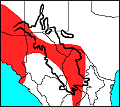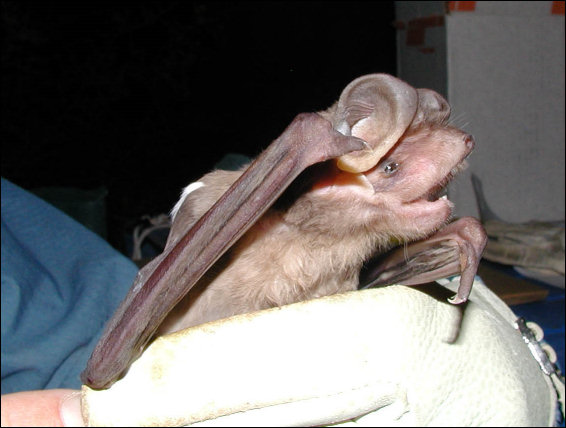


A specimen of Eumops captured at Quitobaquito Pond in southern Arizona for banding and release. Photograph courtesy of the U.S. Park Service.
The Greater Bonneted bat, sometimes called the Western Mastiff Bat, is the largest bat occurring in the United States. These bats tend to inhabit desert, chaparral, oak woodlands, and open ponderosa pine forests, generally with close proximity to cliffs (Tuttle, 2003). This bat generally seeks daytime refuge in crevices of rock walls that form vertical or nearly vertical cliffs (Davis and Schmidly, 1994). The roost entrances typically are horizontally oriented, have moderately large openings, and face downward so they can be entered from below (Schmidly, 1977). "In Capote Canyon in Presidio County, Texas, these bats were found utilizing a crevice formed by exfoliation of the nearly vertical rim rock. There are openings on both the lower and upper edges of the slab. At this site the canyon wall is about 38 m high and the rather steep slope below the cliff has no tall vegetation that might obstruct the takeoff and landing of the bat." (Davis and Schmidly, 1994:80). Most authors agree that the bats choose a roost below which there is an unobstructed drop of several meters so that the emerging bats can drop and gain sufficient momentum to become airborne. The Western Mastiff Bat normally prefers a colonial roosting site with fewer than 100 members, but there are some instances when it will roost individually (Burt and Grossenheider, 1976). They are not known to migrate but may enter a brief period of torpor during extreme weather, and year-round roosting colonies will often include a dominant male sharing the roost with several females (Tuttle, 2003).
Burt, W. H., and R. P. Grossenheider. 1976. A field guide to the mammals. Houghton Mifflin, Boston.
Davis, W. B., and D. J. Schmidly. 1994. The mammals of Texas. Texas Parks and Wildlife Press, Austin.
Schmidly, D. J. 1977. The mammals of Trans-Pecos Texas including Big Bend National Park and Guadalupe Mountains National Park. Texas A&M University Press, College Station.
Tuttle, M. D. 2003. Texas bats. Bat Conservation International, Inc., Austin.
A. Ruth Huckaby, Graduate Student, BIOL 5301-Natural History of the Chihuahuan Desert, June, 2006.
Huckaby Update: 22 June 2006
Last Update: 21 Jul 2009